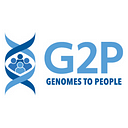Newborn Genome Sequencing: The next step in public health?
For the first time in history, we can treat the underlying cause of some genetic diseases — if we catch them early enough. What does this mean for public health?
by Bethany Zettler, MS, CGC
Newborn screening as we know it began in 1963, and today the program looks for just a few dozen conditions. In the near future, this may expand to screen healthy babies for thousands of genetic risks at birth, some of which can be treated to prevent devastating outcomes.
New parents may remember, in the haze of their baby’s first 48 hours, a clinician pricking their newborn’s heel and collecting a few drops of blood on a paper card, as required by law for most babies in the United States. A few days later, parents receive their baby’s results for a select list of genetic conditions that can be detected by biochemical analysis. This list of 35 conditions — the Recommended Uniform Screening Panel — focuses on those for which action is needed urgently and for which an effective treatment is available. Some states have added additional tests, but none are using genetic testing as the first tier of screening.
If you know much about the state of genome sequencing, especially its increasing application in medical settings, you might wonder: Why stop at 35, or even 60? We have discovered gene associations for thousands of conditions, so why not sequence a newborn’s whole genome and see what else might be prevented?
It’s complicated. But also: Good question.
The BabySeq Project, a randomized controlled trial with more than 300 participating families, asked the same question, following parents and clinicians through the process of comprehensive newborn genomic sequencing. This project produced the first evidence supporting the potential of newborn sequencing from a medical, behavioral, and economic perspective.
It also paved the way for a new NIH-funded continuation of the BabySeq Project, which will include a more diverse cohort to help address ongoing disparities in genomic research. A group of community stakeholders is partnering with the research team for long-term input and oversight. BabySeq envisions a future where newborn genome sequencing is equitably available as an option for any parents who want it — not just early adopters and those with means.
Back to the question, though: Why don’t we already screen newborns for more conditions? In fact, given how much easier and cheaper genome sequencing has become, why not screen for way more conditions?
(Note: There is a whole conversation here about bureaucracy, and medical infrastructure, and healthcare spending, and the logistics of implementing such a huge shift toward proactive medicine. We’re working with Ariadne Labs to explore these issues and develop sustainable tools to support Precision Population Health. Stay tuned for more details another time!)
Much of the current hesitancy stems from the focus on urgent and actionable conditions, where something needs to be done very early in life in order to prevent harm, and where something actually can be done. The current newborn screening list leaves behind the thousands of genetic disorders that can be detected in newborns, but have no approved treatment.
Yet for some of those conditions, treatments are available now, or are about to be, thanks to recent developments in gene-targeted therapies. Between the first and second phases of the BabySeq projects, two gene therapy treatments received FDA approval for use in kids. Now, children with rare genetic forms of neuromuscular disease and vision loss can receive effective, personalized treatment for the first time in history. With hundreds more gene therapies in trials, this is just the tip of the iceberg.
By targeting the exact cause of disease, gene therapies have enormous potential to treat genetic conditions — but need to be administered before symptoms develop. Genetic conditions typically get worse over time, and children need to have healthy cells left to hope for any benefit from treatment. In other words, as new gene therapies become available, the list of conditions that are both urgent and actionable is going to grow, perhaps exponentially. Still, each of those conditions could take years to make it onto the standard newborn screening panel, even with proven treatments available, and most probably won’t make it at all.
Which brings us back to newborn genome sequencing. This would give parents the option to screen for thousands of conditions at once, and could connect their child with approved therapies or ongoing trials — all before symptoms appear, when it may be too late. It can also provide advance notice of later childhood-onset diseases, and could be a lifelong resource, with updates as new gene associations and treatments are discovered.
Does it make sense for newborn genome sequencing to be legally required, like today’s conventional state-mandated newborn screening? Probably not. But given its enormous potential to save lives and prevent suffering, making genome sequencing available as an option for all newborns is about to become an ethics and public health imperative.
Bethany Zettler is a Genomes2People team member, project manager of The BabySeq Project, and lead genetic counselor for the Brigham Preventive Genomics Clinic.
